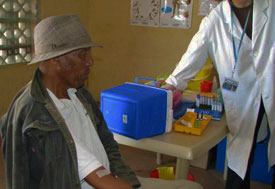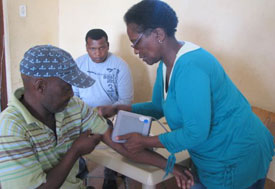Reducing the guesswork and cost of rating heart disease
September / October 2011 | Volume 10, Issue 5

Photo courtesy of Dr. Thomas Gaziano
In South Africa, 25 percent of health care spending
is already devoted to treating heart disease. A
Fogarty-funded program is studying an inexpensive
method of assessing risk of heart problems.
By Steve Goldstein
An overweight, 55-year-old South African man was feeling so poorly he skipped work to see a doctor at a clinic near Cape Town. A smoker, he was diagnosed with hypertension by Fogarty grantee Dr. Thomas Gaziano. But it was the end of the month and the pharmacy had run out of blood pressure medicine. The man went home without the drugs and skipped his next appointment. Gaziano was at the clinic for a year and never saw the patient again.
"It was a missed opportunity," Gaziano said of the lack of drugs, recalling the incident in his office at Boston's Brigham and Women's Hospital. But, he added, an inexpensive way to assess the patient's overall risk of heart disease could have resulted in successful treatment much earlier.
Gaziano's goal was to devise just such a low-cost tool to determine each patient's risk of disease. Eliminating costly lab work from risk assessment tests could prove a watershed in treating cardiovascular disease in developing countries.
Cardiovascular disease, or CVD, is the number one killer worldwide at 30 percent of all deaths, and accounts for 60 percent of all non-communicable diseases. In low- and middle-income countries, CVD is responsible for about 28 percent of all deaths and is growing rapidly. In South Africa, 25 percent of health care spending is already devoted to treating heart disease.
Since 2004, Gaziano has been working in South Africa and India to develop an inexpensive method of assessing risk of cardiovascular disease, funded by a Fogarty International Research Scientist Development Award (IRSDA), with additional support from the National Heart, Lung and Blood Institute.
Given the limited resources in developing countries, Gaziano set out to find a cost-effective risk assessment tool that modified the established Framingham Heart Study factors by substituting body mass index for blood cholesterol, along with blood pressure, diabetes, smoking age and sex. "With a blood test for cholesterol there was a cost, it was not available in many places, people frequently had to travel long distances for testing - losing time and work - so they might not be willing to do so," Gaziano explained.

Photo courtesy of Dr. Thomas Gaziano
Dr. Gaziano envisions training South African
community health workers to use risk assessment
and screening tools for treatment of heart disease
at fairs or church days, where people routinely
gather.
The question was whether removing the cholesterol test would significantly alter the predictive effectiveness of the risk assessment.
What was needed was data from a span of years to see what disease developed - information that was not available in South Africa. In a study published in The Lancet in 2008, Gaziano and his fellow researchers used data from 15,000 U.S. patients in 1971 and substituted BMI for cholesterol and then applied follow-up data on the same patients from 1992.
"We found no difference in ability to assess total risk if we substituted BMI for cholesterol," said Gaziano. He also found that the U.S. data from 1971 looked like South Africa in 2010 - high smoking rates, elevated cholesterol levels and low treatment rates. "So the U.S. looked like a developing country at that time in many ways," he said.
Gaziano's results were later validated by a follow-up study in South Africa that compares scores with and without blood testing. "We found 92 to 99 percent agreement in the scores for assessing risk," he said.
Another part of Gaziano's work is what he calls a "decision analytic model," which calculates the different risk factors and attempts to find the most cost effective way of treating a patient. In other words, what would be the cost of lowering blood pressure at so much per person and what impact would that have on preventing heart attacks and strokes. The goal is to decide which screening method is most cost effective.
For example, in India cholesterol testing costs from $4 to $30 per patient, but the annual per capita health expenditure by the government is only $30, so using cholesterol testing as a risk assessment tool is not sustainable. "So now we've given them another option of how to screen for overall risk," said Gaziano, "and the WHO, as a result of our work, has promulgated new guidelines that do not require cholesterol testing."
Gaziano hopes to test these conclusions in a new trial, funded by NHLBI, with a projected 5,000 to 10,000 participants in South Africa, to gauge the efficacy of the new screening method.
Gaziano describes his work as one study begetting another as he has tried to refine risk assessment and screening tools for treatment of CVD. As the new study gets underway in South Africa, nurses in the Western Cape are using the revised risk tool.
One of the next steps he envisions is to train community health workers to use this risk tool at fairs or church days where people are gathered together. "This would reduce the burden on health centers and make it more likely the right patients get treatment," he said.
More Information
To view Adobe PDF files,
download current, free accessible plug-ins from Adobe's website.